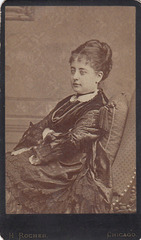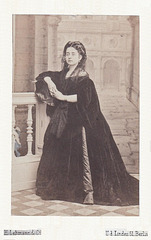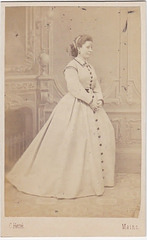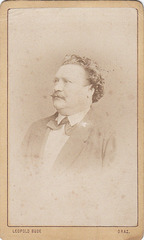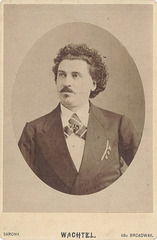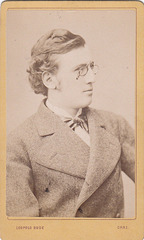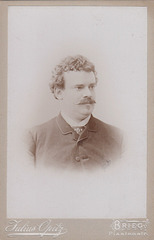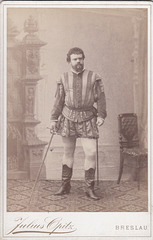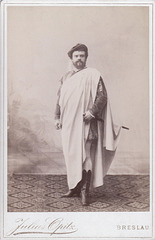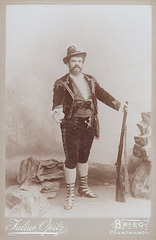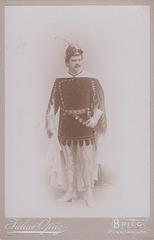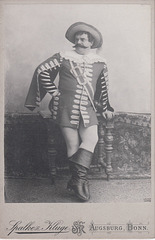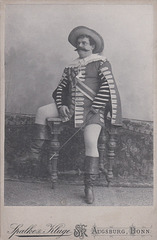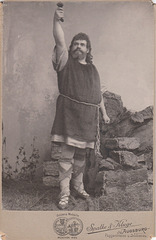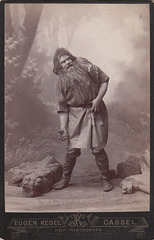
19th century opera singers
Pauline Lucca by Rocher
| |
|
Pauline Lucca (1841-1908); Austrian soprano. She made her debut in 1859 as Elvira in Verdi's "Ernani". In 1861 the composer Meyerbeer -a great admirer of Lucca- made her sign a contract with the Royal Court Opera in Berlin where she stayed several years. During her career she performed in England, France and Russia and she also undertook several tours in America. From 1874-1889 she was engaged by the the Vienna State Opera. Important roles of her were Zerlina in "Fra Diavolo", Cherubino in "Le noze di Figaro", Selika in "L'Africaine" and Carmen in Bizet's eponymous opera. She retired in 1889.
Pauline Lucca by Lehmann (1)
| |
|
Pauline Lucca (1841-1908); Austrian soprano. She made her debut in 1859 as Elvira in Verdi's "Ernani". In 1861 the composer Meyerbeer -a great admirer of Lucca- made her sign a contract with the Royal Court Opera in Berlin where she stayed several years. During her career she performed in England, France and Russia and she also undertook several tours in America. From 1874-1889 she was engaged by the the Vienna State Opera. Important roles of her were Zerlina in "Fra Diavolo", Cherubino in "Le noze di Figaro", Selika in "L'Africaine" and Carmen in Bizet's eponymous opera. She retired in 1889.
On the photo she is seen as Leonora in Donizetti’s "La Favorita".
Jenny Soltana-Henz by Hertel (2)
| |
|
Jenny Soltana-Henz (1840-?); German soprano.
In 1864 she made her debut at the “Hoftheater von Mannheim” as Agathe in “Der Freischütz”. She remained in Mannheim until 1866 and the next season she was engaged at the “Stadttheater von Mainz”. From 1867 until her retirement from the stage in 1881 she was engaged at the “Hoftheater von Kassel”. In the 1860s she was successful with guest appearances at the leading German opera houses in Berlin, Munich, Dresden, Frankfurt a.M. and Braunschweig. Her most memorable rôles were the Countess in “Le nozze di Figaro”, Pamina in “Der Zauberflöte”, Agathe in “Der Freischütz”, Elsa in “Lohengrin” and Donna Anna in “Don Giovanni”.
Mieczyslaw von Kaminski by Bude
| |
|
Mieczyslaw von Kaminski (1835-1896); Polish tenor.
In 1856 he made his debut as Tannhäuser at the “Theater in der Josefstadt” in Vienna. This was also the Viennese première of this Wagner opera. Then he made an extended tour through Austria and Germany where he made guest appearances at Graz, Stuttgart, Leipzig, Berlin, Bremen and Hamburg. In 1859 he returned to his native country Poland where he was engaged at the Warsaw Opera from 1862/65. In the following years he again made tours with guest appearances in Germany, Austria, Switzerland, France and Italy. In 1887 he retired from the stage at the Opera in Lwów, where he also worked as opera director from 1889 until 1895. His most memorable rôles were Pollione in “Norma”, Edgardo in “Lucia di Lammermoor”, Arnoldo in “Guillaume Tell”, Manrico in “Il Trovatore”, Robert in “Robert le Diable”, Eleazar in “La Juive”, Max in “Der Freischütz”, Arturo in “I Puritani” and Fernando in “La Favorita”. He published his memoires in the Polish magazine “Wedrowiec”.
Theodor Wachtel by Sarony
| |
|
Theodor Wachtel (1823-1893); German tenor.
He made his debut in 1849 as Arturo in “Lucia di Lammermoor”. The first decade of his carreer was not very successful, performing in a number of small town German operahouses. From 1863 till 1868 he was associated with the “Berliner Hofoper” where he made his debut also in “Lucia di Lammermoor” but this time in the rôle of Edgardo. In 1865 he sang at Covent Garden in the English première of “L’Africaine” the rôle of Vasco da Gama with Pauline Lucca as Selika. In the 1870s he made several America-tours. His most famous rôle was Chapelou in Adam’s “Le postillon de Lonjumeau” ; his high tenor voice and brillant high C from the chest made him the perfect interpretor for this rôle. In Germany he performed “Le postillon de Lonjumeau” over a 1000 times.
August Stoll by Bude
| |
|
August Stoll (1853-1918); Transylvanian tenor.
He was the son of tenor Peter Stoll (1813-1888) who was engaged at the Budapest Opera as “first tenor” for 33 years. His father was also his singing teacher. In 1869 he made his debut as a choir singer in Ljubljana. For 4 years he performed both as an actor and as an operetta singer in Bozen, Pressburg, Olmütz and Vienna. In 1873 he returned to Ljubljana, but this time as an opera singer. In 1875/84 he was engaged at the “Deutsche Theater” in Prague where he was very successful. In 1884 he went to Vienna; first at the “Theater an der Wien” and from 1888 on at the “Hofoper”. From 1890 until 1901 he was a professor at the Vienna Conservatory. He composed several vocal works and an operetta “Die Georginen”.
Fritzi Heukeshoven by Atelier Elvira
| |
|
|
Fritzi Heukeshoven was the daughter of Fritz Heukeshoven.
On the photo she is seen at the age of 15.
Vilma Rafael by Kaldori
| |
|
|
Vilma Rafael was the wife of Fritz Heukeshoven (1855-1926); they married in 1881.
On the photo she is seen as Bocaccio.
Fritz Heukeshoven by Opitz (1)
| |
|
Fritz Heukeshoven (1855-1926); German tenor.
In the season 1878/79 he started his career at the “Stadttheater von Strassburg”. In the following years he was engaged at Thüringen (1879/80), Zürich (1880/82), Graz (1882/83), Kassel (1883/86) Prague (1886/88), Breslau (1888/90) and Wiesbaden (1890/93). At the end of his career he performed at Nürnberg (1893/94), Augsburg (1894/97) and Basel (1897/1904). Until 1908 he made guest appearances every now and then. At the beginning of his career he performed roles like Lyonel in “Martha”, Almaviva in “Il barbiere di Siviglia”, Georges Brown in “La Dame Blanche” and Fra Diavolo. Later on his career he also sang more dramatic roles like Pollione in “Norma”, Manrico in “Il Trovatore”, Raoul in “Les Huguenots”, Jean de Leyde in “Le Prophet”, Arnoldo in “Guillaume Tell, Eleazar in “La juive”, Canio in “I Pagliacci” and various Wagner roles. His total repertoire consisted of 140 roles. Added to this was an equally versatile repertoire for the concert hall.
Fritz Heukeshoven by Opitz (2)
| |
|
Fritz Heukeshoven (1855-1926); German tenor.
In the season 1878/79 he started his career at the “Stadttheater von Strassburg”. In the following years he was engaged at Thüringen (1879/80), Zürich (1880/82), Graz (1882/83), Kassel (1883/86) Prague (1886/88), Breslau (1888/90) and Wiesbaden (1890/93). At the end of his career he performed at Nürnberg (1893/94), Augsburg (1894/97) and Basel (1897/1904). Until 1908 he made guest appearances every now and then. At the beginning of his career he performed roles like Lyonel in “Martha”, Almaviva in “Il barbiere di Siviglia”, Georges Brown in “La Dame Blanche” and Fra Diavolo. Later on his career he also sang more dramatic roles like Pollione in “Norma”, Manrico in “Il Trovatore”, Raoul in “Les Huguenots”, Jean de Leyde in “Le Prophet”, Arnoldo in “Guillaume Tell, Eleazar in “La juive”, Canio in “I Pagliacci” and various Wagner roles. His total repertoire consisted of 140 roles. Added to this was an equally versatile repertoire for the concert hall.
On the photo from 1889 he is seen as Jan de Leyde in Meyerbeer’s opera “Le Prophète”.
Fritz Heukeshoven by Opitz (3)
| |
|
Fritz Heukeshoven (1855-1926); German tenor.
In the season 1878/79 he started his career at the “Stadttheater von Strassburg”. In the following years he was engaged at Thüringen (1879/80), Zürich (1880/82), Graz (1882/83), Kassel (1883/86) Prague (1886/88), Breslau (1888/90) and Wiesbaden (1890/93). At the end of his career he performed at Nürnberg (1893/94), Augsburg (1894/97) and Basel (1897/1904). Until 1908 he made guest appearances every now and then. At the beginning of his career he performed roles like Lyonel in “Martha”, Almaviva in “Il barbiere di Siviglia”, Georges Brown in “La Dame Blanche” and Fra Diavolo. Later on his career he also sang more dramatic roles like Pollione in “Norma”, Manrico in “Il Trovatore”, Raoul in “Les Huguenots”, Jean de Leyde in “Le Prophet”, Arnoldo in “Guillaume Tell, Eleazar in “La juive”, Canio in “I Pagliacci” and various Wagner roles. His total repertoire consisted of 140 roles. Added to this was an equally versatile repertoire for the concert hall.
On the photo from 1889 he is seen as Jan de Leyde in Meyerbeer’s opera “Le Prophète”.
Fritz Heukeshoven by Opitz (4)
| |
|
Fritz Heukeshoven (1855-1926); German tenor.
In the season 1878/79 he started his career at the “Stadttheater von Strassburg”. In the following years he was engaged at Thüringen (1879/80), Zürich (1880/82), Graz (1882/83), Kassel (1883/86) Prague (1886/88), Breslau (1888/90) and Wiesbaden (1890/93). At the end of his career he performed at Nürnberg (1893/94), Augsburg (1894/97) and Basel (1897/1904). Until 1908 he made guest appearances every now and then. At the beginning of his career he performed roles like Lyonel in “Martha”, Almaviva in “Il barbiere di Siviglia”, Georges Brown in “La Dame Blanche” and Fra Diavolo. Later on his career he also sang more dramatic roles like Pollione in “Norma”, Manrico in “Il Trovatore”, Raoul in “Les Huguenots”, Jean de Leyde in “Le Prophet”, Arnoldo in “Guillaume Tell, Eleazar in “La juive”, Canio in “I Pagliacci” and various Wagner roles. His total repertoire consisted of 140 roles. Added to this was an equally versatile repertoire for the concert hall.
On the photo from 1889 he is seen as Fra Diavolo in the eponymous opera by Auber.
Fritz Heukeshoven by Opitz (5)
| |
|
Fritz Heukeshoven (1855-1926); German tenor.
In the season 1878/79 he started his career at the “Stadttheater von Strassburg”. In the following years he was engaged at Thüringen (1879/80), Zürich (1880/82), Graz (1882/83), Kassel (1883/86) Prague (1886/88), Breslau (1888/90) and Wiesbaden (1890/93). At the end of his career he performed at Nürnberg (1893/94), Augsburg (1894/97) and Basel (1897/1904). Until 1908 he made guest appearances every now and then. At the beginning of his career he performed roles like Lyonel in “Martha”, Almaviva in “Il barbiere di Siviglia”, Georges Brown in “La Dame Blanche” and Fra Diavolo. Later on his career he also sang more dramatic roles like Pollione in “Norma”, Manrico in “Il Trovatore”, Raoul in “Les Huguenots”, Jean de Leyde in “Le Prophet”, Arnoldo in “Guillaume Tell, Eleazar in “La juive”, Canio in “I Pagliacci” and various Wagner roles. His total repertoire consisted of 140 roles. Added to this was an equally versatile repertoire for the concert hall.
On the photo from 1889 he is seen as Manrico in Verdi’s opera “Il Trovatore”.
Fritz Heukeshoven by Spalke & Kluge (1)
| |
|
Fritz Heukeshoven (1855-1926); German tenor.
In the season 1878/79 he started his career at the “Stadttheater von Strassburg”. In the following years he was engaged at Thüringen (1879/80), Zürich (1880/82), Graz (1882/83), Kassel (1883/86) Prague (1886/88), Breslau (1888/90) and Wiesbaden (1890/93). At the end of his career he performed at Nürnberg (1893/94), Augsburg (1894/97) and Basel (1897/1904). Until 1908 he made guest appearances every now and then. At the beginning of his career he performed roles like Lyonel in “Martha”, Almaviva in “Il barbiere di Siviglia”, Georges Brown in “La Dame Blanche” and Fra Diavolo. Later on his career he also sang more dramatic roles like Pollione in “Norma”, Manrico in “Il Trovatore”, Raoul in “Les Huguenots”, Jean de Leyde in “Le Prophet”, Arnoldo in “Guillaume Tell, Eleazar in “La juive”, Canio in “I Pagliacci” and various Wagner roles. His total repertoire consisted of 140 roles. Added to this was an equally versatile repertoire for the concert hall.
On the photo from 1897 he is seen as The Duke of Mantua in Verdi’s opera “Rigoletto”.
Fritz Heukeshoven by Spalke & Kluge (2)
| |
|
Fritz Heukeshoven (1855-1926); German tenor.
In the season 1878/79 he started his career at the “Stadttheater von Strassburg”. In the following years he was engaged at Thüringen (1879/80), Zürich (1880/82), Graz (1882/83), Kassel (1883/86) Prague (1886/88), Breslau (1888/90) and Wiesbaden (1890/93). At the end of his career he performed at Nürnberg (1893/94), Augsburg (1894/97) and Basel (1897/1904). Until 1908 he made guest appearances every now and then. At the beginning of his career he performed roles like Lyonel in “Martha”, Almaviva in “Il barbiere di Siviglia”, Georges Brown in “La Dame Blanche” and Fra Diavolo. Later on his career he also sang more dramatic roles like Pollione in “Norma”, Manrico in “Il Trovatore”, Raoul in “Les Huguenots”, Jean de Leyde in “Le Prophet”, Arnoldo in “Guillaume Tell, Eleazar in “La juive”, Canio in “I Pagliacci” and various Wagner roles. His total repertoire consisted of 140 roles. Added to this was an equally versatile repertoire for the concert hall.
On the photo from 1897 he is seen as The Duke of Mantua in Verdi’s opera “Rigoletto”.
Fritz Heukeshoven by Spalke & Kluge (3)
| |
|
Fritz Heukeshoven (1855-1926); German tenor.
In the season 1878/79 he started his career at the “Stadttheater von Strassburg”. In the following years he was engaged at Thüringen (1879/80), Zürich (1880/82), Graz (1882/83), Kassel (1883/86) Prague (1886/88), Breslau (1888/90) and Wiesbaden (1890/93). At the end of his career he performed at Nürnberg (1893/94), Augsburg (1894/97) and Basel (1897/1904). Until 1908 he made guest appearances every now and then. At the beginning of his career he performed roles like Lyonel in “Martha”, Almaviva in “Il barbiere di Siviglia”, Georges Brown in “La Dame Blanche” and Fra Diavolo. Later on his career he also sang more dramatic roles like Pollione in “Norma”, Manrico in “Il Trovatore”, Raoul in “Les Huguenots”, Jean de Leyde in “Le Prophet”, Arnoldo in “Guillaume Tell, Eleazar in “La juive”, Canio in “I Pagliacci” and various Wagner roles. His total repertoire consisted of 140 roles. Added to this was an equally versatile repertoire for the concert hall.
On the photo from 1897 he is seen as Siegmund in Wagner’s opera “Die Walküre”.
Fritz Heukeshoven by Kegel (1)
| |
|
|
Fritz Heukeshoven (1855-1926); German tenor.
In the season 1878/79 he started his career at the “Stadttheater von Strassburg”. In the following years he was engaged at Thüringen (1879/80), Zürich (1880/82), Graz (1882/83), Kassel (1883/86) Prague (1886/88), Breslau (1888/90) and Wiesbaden (1890/93). At the end of his career he performed at Nürnberg (1893/94), Augsburg (1894/97) and Basel (1897/1904). Until 1908 he made guest appearances every now and then. At the beginning of his career he performed roles like Lyonel in “Martha”, Almaviva in “Il barbiere di Siviglia”, Georges Brown in “La Dame Blanche” and Fra Diavolo. Later on his career he also sang more dramatic roles like Pollione in “Norma”, Manrico in “Il Trovatore”, Raoul in “Les Huguenots”, Jean de Leyde in “Le Prophet”, Arnoldo in “Guillaume Tell, Eleazar in “La juive”, Canio in “I Pagliacci” and various Wagner roles. His total repertoire consisted of 140 roles. Added to this was an equally versatile repertoire for the concert hall.
On the photo from 1884 he is seen as Mime in Wagner’s opera “Siegfried”.
Fritz Heukeshoven by Kegel (2)
| |
|
Fritz Heukeshoven (1855-1926); German tenor.
In the season 1878/79 he started his career at the “Stadttheater von Strassburg”. In the following years he was engaged at Thüringen (1879/80), Zürich (1880/82), Graz (1882/83), Kassel (1883/86) Prague (1886/88), Breslau (1888/90) and Wiesbaden (1890/93). At the end of his career he performed at Nürnberg (1893/94), Augsburg (1894/97) and Basel (1897/1904). Until 1908 he made guest appearances every now and then. At the beginning of his career he performed roles like Lyonel in “Martha”, Almaviva in “Il barbiere di Siviglia”, Georges Brown in “La Dame Blanche” and Fra Diavolo. Later on his career he also sang more dramatic roles like Pollione in “Norma”, Manrico in “Il Trovatore”, Raoul in “Les Huguenots”, Jean de Leyde in “Le Prophet”, Arnoldo in “Guillaume Tell, Eleazar in “La juive”, Canio in “I Pagliacci” and various Wagner roles. His total repertoire consisted of 140 roles. Added to this was an equally versatile repertoire for the concert hall.
On the photo from 1884 he is seen as Mime in Wagner’s opera “Siegfried”.
Jump to top
RSS feed- Latest items - Subscribe to the latest items added to this album
- ipernity © 2007-2024
- Help & Contact
|
Club news
|
About ipernity
|
History |
ipernity Club & Prices |
Guide of good conduct
Donate | Group guidelines | Privacy policy | Terms of use | Statutes | In memoria -
Facebook
Twitter

